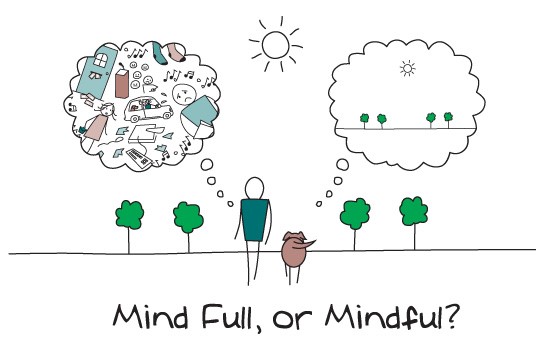Mindfulness seems to be the new “buzz word” in today’s popular culture. A quick Google search for “mindfulness” yields almost 6 million results! This word is being tossed around in advertising, media, sermon series, and everyday conversation. Some of you may be left wondering, what is mindfulness, really?
There are many definitions of mindfulness, but my favorite belongs to Jon Kabat-Zinn, a mindfulness expert who developed the technique Mindfulness-Based Stress Reduction to address a variety of physical health ailments. Kabat-Zinn defines mindfulness as, “paying attention in a particular way, on purpose, in the moment, and nonjudgmentally.” In other words, mindfulness is being intentionally aware of all the things making up this particular moment – your surroundings, thoughts, emotions, and physical sensations – without analyzing or trying to change them. Many of us mentally live in the past, ruminating about old wounds or resentments, or we are caught up worrying about the future, whether it is what we are going to eat for dinner or how we are going to pay for our child’s college tuition. Whether we are mentally in the past or the future, we are not in the present, which means we are missing out on what is happening in our lives right now.
Living in the present, not the past or the future, is a choice to be intentional about your life. How do we live more fully in the present? The answer is in being mindful. Being mindful is a big step on the path to living On Purpose. Mindfulness is a skill, and, just like any other skill, we have to practice regularly if we want to get better at it. Here’s an idea for a simple mindfulness practice you can do each day:
Physical grounding. Place both feet on the floor, and sit in a comfortable position. Close your eyes, and breathe naturally. Turn your attention to the sensation in your feet as they rest on the floor. Try wiggling your toes or rocking back on your heels and just notice how that physically feels. Now turn your attention to the feeling of the backs of your legs as they press against the chair beneath you. Notice if the chair feels hot or cold, smooth or rough, supportive or squishy. Finally, turn your attention to the feeling of your back being supported by the back of your seat. Just notice the feeling of being grounded physically and being aware of your body as you breathe normally.
Daily mindfulness practice has been shown to reduce stress, relieve physical and emotional pain, decrease anxiety, and increase a person’s sense of well-being. I hope you will consider adding this simple, but powerful, practice to your life.
Have a mindful day!
Erica Skidmore, Psy.D.
Founder, On Purpose Press

